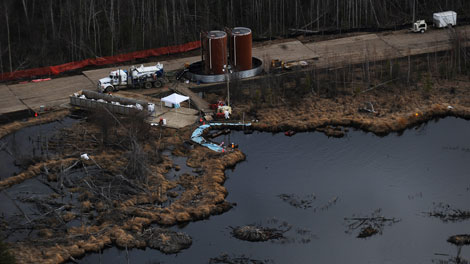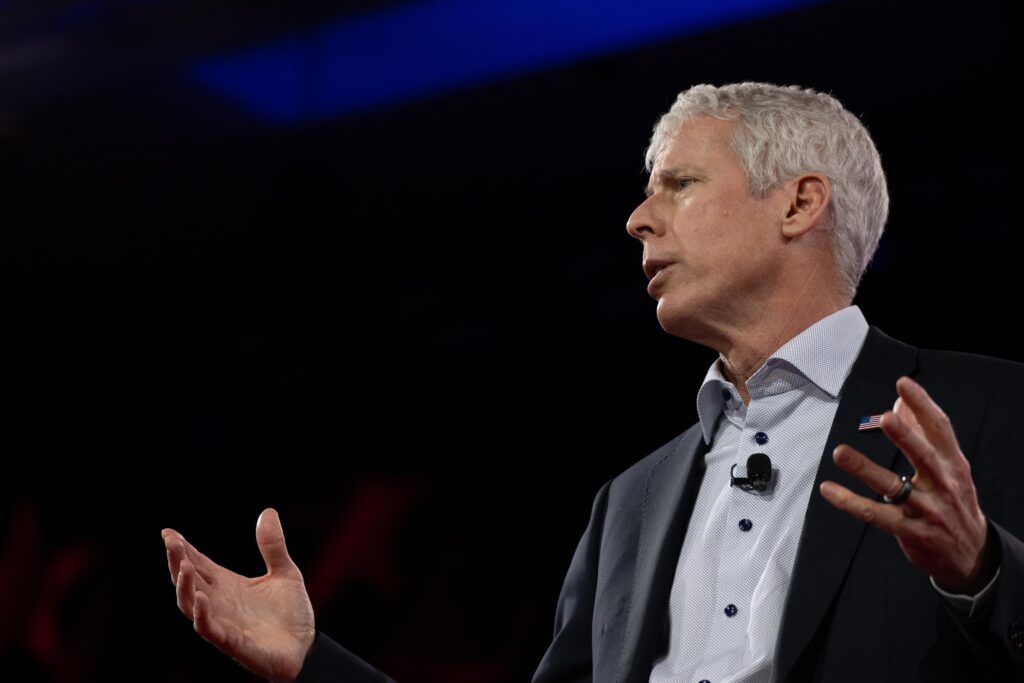Right now, the oil and gas industry is holding its breath as the approval of two major tar sands pipelines hang in the balance. The $13 billion Keystone XL pipeline would significantly increase the Canadian export of of dirty tar sands bitumen to the U.S. by as much as 510,000 barrels a day. And, on this side of the border, the ferociously debated $5.5 billion, 1,170 kilometre Enbridge Northern Gateway pipeline would carry dirty tar sands bitumen to Kitimat, B.C., where it would be loaded onto supertankers bound for growing energy markets in Asia.
As the decisions near, a series of major oil spills in the last year have highlighted the dangers these two pipelines pose, particularly given the major expansion of tar sands production they would enable.
This week, a pump-station equipment failure at a TransCanada pipeline caused 80,000 litres of oil to spill in North Dakota. The Keystone system has suffered 12 leaks since it opened last June, all of them related to equipment failures at pump stations. Despite the frequent spill record, the pipeline is due to resume operations on Saturday.
The pipeline currently carries up to 591,000 barrels a day of crude from northern Alberta to the oil-storage crossroads in Oklahoma and refineries in Illinois. TransCanada is seeking approval from the U.S. State Department to expand the Keystone system to 1.1 million barrels a day and to extend it from Cushing, Oklahoma to refineries on the U.S. Gulf coast. A decision is expected this year.
In addition to the North Dakota leak, Enbridge announced yesterday that it discovered a small leak on its Norman Wells line in the Northwest Territories. The spill’s effects were likely mitigated because the line had already been shut down due to a major spill in Alberta on April 29th, when 28,000 barrels of oil spilled from the rupture of a Plains All American Pipeline. The spill is Alberta’s worst in 35 years, and was more than a third larger than the spill that rocked Michigan in 2010.
On April 30th, Plains Midstream Canada, the Canadian subsidiary of Plains All American, quietly issued a press release informing the public of the crude spill from the Rainbow Pipeline in northern Alberta near Little Buffalo, AB. The spill was thought to be small, and it took a full four days for Alberta’s Energy Resources Conservation Board (ERCB) to issue an announcement that a major spill had occurred.
The ERCB and industry have been under fire for failing to disclose details about the major spill earlier. According to NDP MLA Rachel Notley, “we did not get public notice of the extent of this breach until Tuesday, the day after the federal election”. The Pembina Institute’s Chris Severson-Baker raised concerns about how slowly information has been to get to Albertans and Canadians.
Alberta’s Environment Minister Rob Renner failed to make an appearance at the spill site and then applauded the industry’s track record on spills.
Industry and government would have us believe that pipeline spills are few and far between. Indeed, Plains Midstream Canada maintains that the Alberta spill was a one-time event.
In reality, spills are commonplace. After researching the 1975 spill that is considered Alberta’s largest in history (gushing 6.5 million litres of oil), Sean Kheraj learned that Alberta has a long and troubled history of oil spills. According to his research, pipeline failures have been a regular occurrence since the 1970s.
A 2007 report by the Alberta Energy Utilities Board on pipeline performance found that between 1990 and 2005, there were nearly 5,000 pipeline releases of hydrocarbon liquids. 4,717 spills released less than 1,000 litres of oil, 46 released between 100,000 litres and 1 million litres, and 6 released between 1 million and 10 million litres.
In 1970, for example, a massive break in a Great Canadian Oil Sands Ltd. (now Suncor) pipeline in northern Alberta caused nearly 190,000 litres of synthetic crude to pump into the Athabasca River.
Then, that same year, two separate pipeline ruptures released 158,000 litres of crude into Freeman River and Lake. In 1971, Imperial Oil was responsible for a 4.5 million litre spill west of Edmonton. Two years later, a Gulf Alberta pipeline burst near Camrose spilled roughly 1.1 million litres of crude oil. Through the latter part of the 1970s, a series of spills ravaged Alberta including an Interprovincial Pipeline Company leak in Killam, Alberta that spilled 3 million litres of oil.
Alberta’s pipelines are particularly prone to leak. A 2011 report from the Natural Resources Defense Council (NRDC) noted that Alberta has suffered 218 spills greater than 100 litres per 10,000 miles of pipeline caused by internal corrosion from 2002 to 2010, compared to the rate of 13.6 spills greater than 100 litres per 10,000 miles of pipeline from internal corrosion reported in the United States.
Tar sands crude is proven to be more acidic and sulphuric than conventional crude oil and contains 15-20 times higher acid concentrations. The additional sulphur in tar sands crude weakens and embrittles pipelines.
And that’s exactly what happened to the Rainbow pipeline that blew in Alberta. In 2006, corrosion in the Rainbow pipeline caused 1.3 million litres of crude to leak near Slave Lake.
Spills in Alberta are not a thing of the past. And, despite what industry says, they are not few and far between. With nearly 5,000 spills over the last 30 years, our dirty oil addiction is even more destructive than we realize.
An investigation into the cause of the recent breach has begun, and while it could take many weeks, the 44 year old pipeline could reopen in the next few days.
While Alberta’s environment minister, Rob Renner, has already apologized to Aboriginal leaders in northern Alberta for the spill, the true damage won’t be known for a long time.
Renner openly admitted that the province and industry should have done a better job of communicating with local communities after the spill. But while he criticizes his government and industry, he also praises them for containing the spill to a small area.
Yet, given the long history of oil spills in Alberta, praise for containing the spills is effectively a dangerous lowering of the bar. It should not be a question of how well the spills are contained, it should be a question of preventing the spills from happening at all.
While the damage from spills is downplayed, the economic benefits of the tar sands are often exaggerated as well. The age-old argument that Alberta’s tar sands are central to the Canadian economy, and that like it or not, we just can’t afford to cap their pollution is moot.
The Canadian Energy Research Institute (CERI) demonstrate that the tar sands only accounted for 1.5 percent of Canadian GDP in 2000, and they only expected that number to rise to 3 percent by 2020. In his recent series in Vancouver Observer, Barry Saxifridge argued that the vast majority of tar sands profits remain in Alberta. Of the 10% of profits that leave Alberta, only 0.2 percent is left for the rest of Canadians.
Translation? The economic benefits of the tar sands are massively over-hyped.
Why would Canada want two more major tar sands pipelines to be built, knowing full well that they will leak,when we can’t even stop leaks from the existing pipelines that are already threatening water and wildlife? How many more spills must happen – many out of the media’s eye – before we realize that our addiction to dirty oil is a recipe for disaster?
Subscribe to our newsletter
Stay up to date with DeSmog news and alerts







